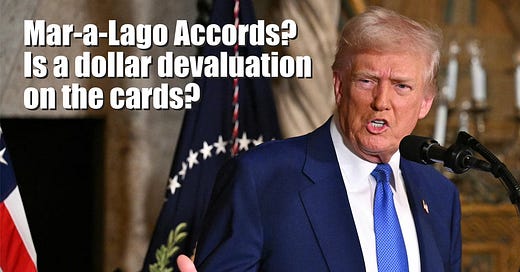Mar-a-Lago Accords - is a dollar devaluation on the cards?
Key Market report for Monday, 19 February 2025
Yesterday, Dan Denning from Bonner Private Research published an excellent interview with Matt Smith discussing what could turn out to be one of the biggest financial shifts in many decades. Based on various statements of the Trump Administration officials and a November 2024 paper titled, "A User's Guide to Restructuring the Global Trading System," Denning and Smith discuss the possible consequences of radical economic policy shifts being considered by the Trump team.
The "User's Guide..." was written by Dr. Stephen Miran, senior strategist at Hudson Bay Capital and former senior economic policy advisor for the U.S. Treasury Department. He is also Trump's nominee for the Chairman of the Council of Economic Policy Advisors.
Miran's central concern is that the economic imbalances plaguing the US economy stem from the "persistent dollar overvaluation that prevents the balancing of international trade, and this overvaluation is driven by inelastic demand for reserve assets. As global GDP grows, it becomes increasingly burdensome for the United States to finance the provision of reserve assets..."
For this reason, "substantial changes to dollar policy" will be considered by the Trump Administration, clearly with the desired effect of eventually devaluing the dollar. However, the policy options available to the administration are complex with a rather rife mix of possible unintended consequences, including adverse impact on capital markets as well as persisting high levels of inflation. In some ways, the administration's policies could also have outcomes opposite of those desired.
The Gordian knot of policy options
For example, to bring back manufacturing to the United States, Trump has imposed tariffs on major trading nations and will likely continue to use tariffs, not only as a foreign trade policy tool but also as a tool of domestic fiscal policy. However, tariffs will likely strengthen the US dollar against currencies of tariffed nations, and could boost consumer price inflation.
For example, with about 10% of consumption deriving from imports and a 10% tariff on all imported goods, all other things being equal, consumer prices should increase by about 1%. But incorporating a 40 to 70 basis point drag on inflation from the increased dollar strength, CPI inflation might only rise by 0.3% to 0.6%. If this were a one-time boost, this would only be a transitory inflation spike. But in "more turbulent times and greater inflationary cross-currents, such a change may ... become more persistent, contributing to a goods-wage inflationary spiral." But notice: tariffs could end up strengthening, not weakening the dollar.
The administration is indeed facing a complex Gordian knot of policy options, including the choice of implementing its measures unilaterally, forcing them on its trading partners, or going with multilateral policy approaches. As Miran points out, "multilateral currency accords have been the principal means of implementing intentional changes in the value of the dollar." Thus, the US, France, Germany, Japan and the UK signed the Plaza Accord of 1985 in a coordinated effort to weaken the dollar.
Today, the Trump Administration is considering the prospective "Mar-a-Lago Accord," with similar objectives. But circumstances have changed radically since the mid-1980s and it remains to be seen whether the administration will be able to secure key trading partners' cooperation. Furthermore, in 1985 the US was signing the Plaza Accord with her allies; this time, the accord with the same group of nations would be much less impactful, and any successful "accord" would depend on China and other leading BRICS nations.
I believe that Miran's "User Guide..." is an important document to read and digest, as it frames the thinking that will guide the Trump Administration's policy decisions. But what it also makes clear is that there are far too many variables in the complex foreign trade and domestic policy equations to make any categorical predictions about the future. To bring manufacturing back home and make it globally competitive, the Trump team will seek to weaken the US dollar and in that, they might ultimately be successful. But achieving that goal will probably have disconcerting consequences including rising commodity prices, higher interest rates and increased volatility in capital markets.
For best results, stick with the trends…
I wholeheartedly believe that many of these changes will shape up as major trends and that navigating the coming changes will be vastly easier by relying on well-formulated systematic trend following strategies such as the ones generating directional exposure and trade timing signals in this newsletter.
To learn more about TrendCompass reports please check our main TrendCompass web page. We encourage you to also have a read through our TrendCompass User Manual page.
Trading signals for Key Markets, 19 Feb. 2025
With yesterday’s closing prices we have the following signals:
Keep reading with a 7-day free trial
Subscribe to I-System TrendCompass to keep reading this post and get 7 days of free access to the full post archives.






